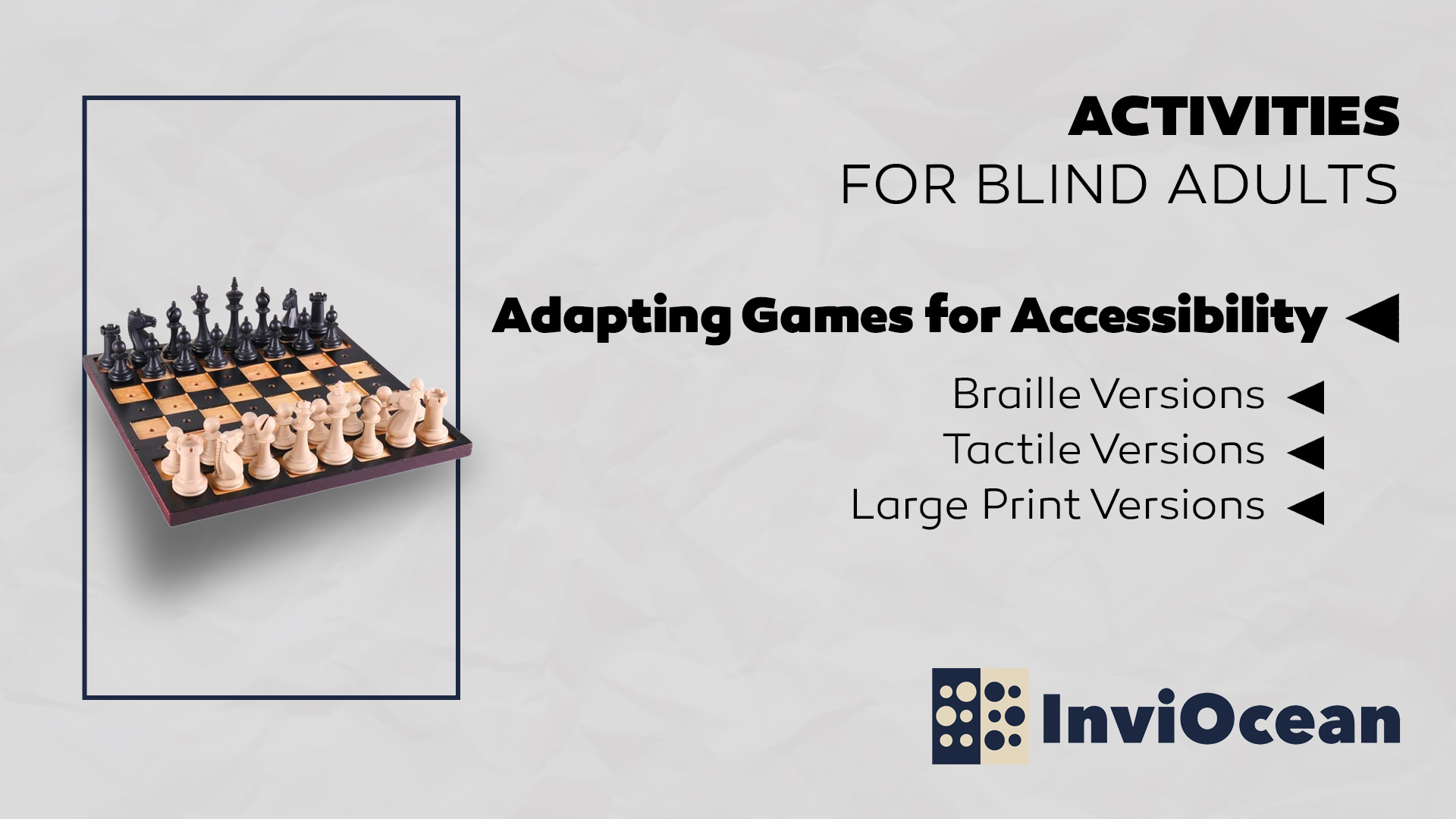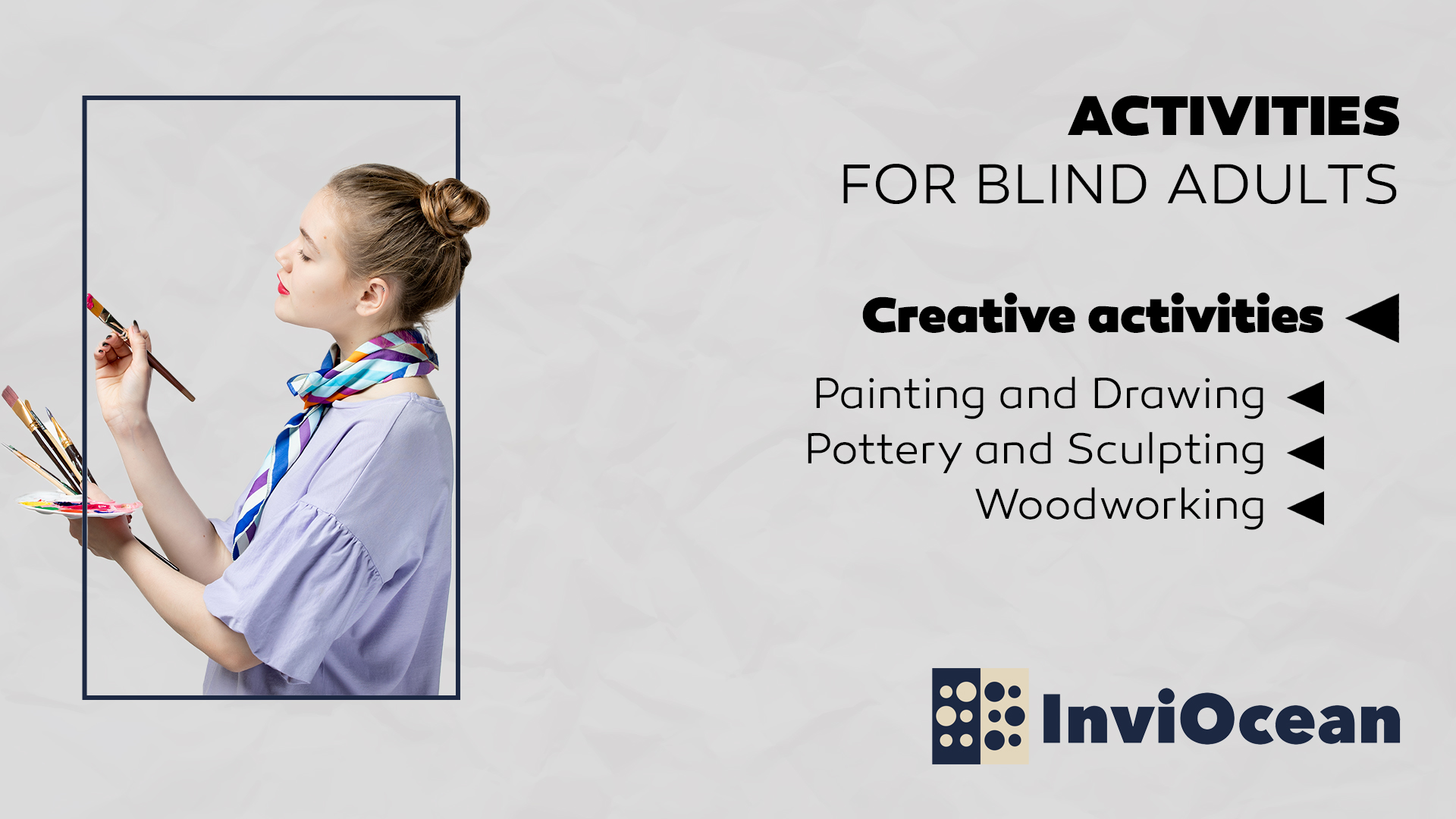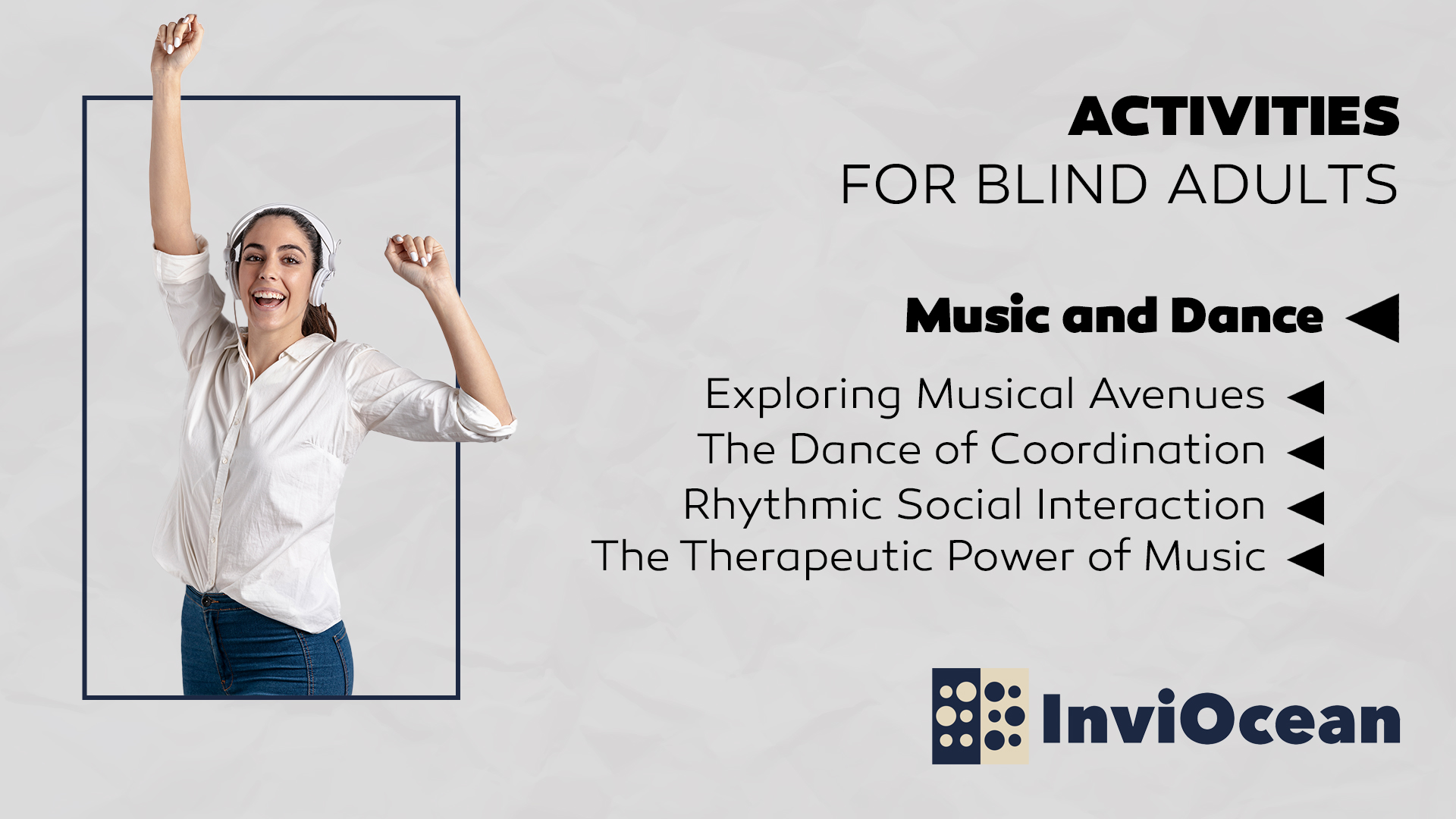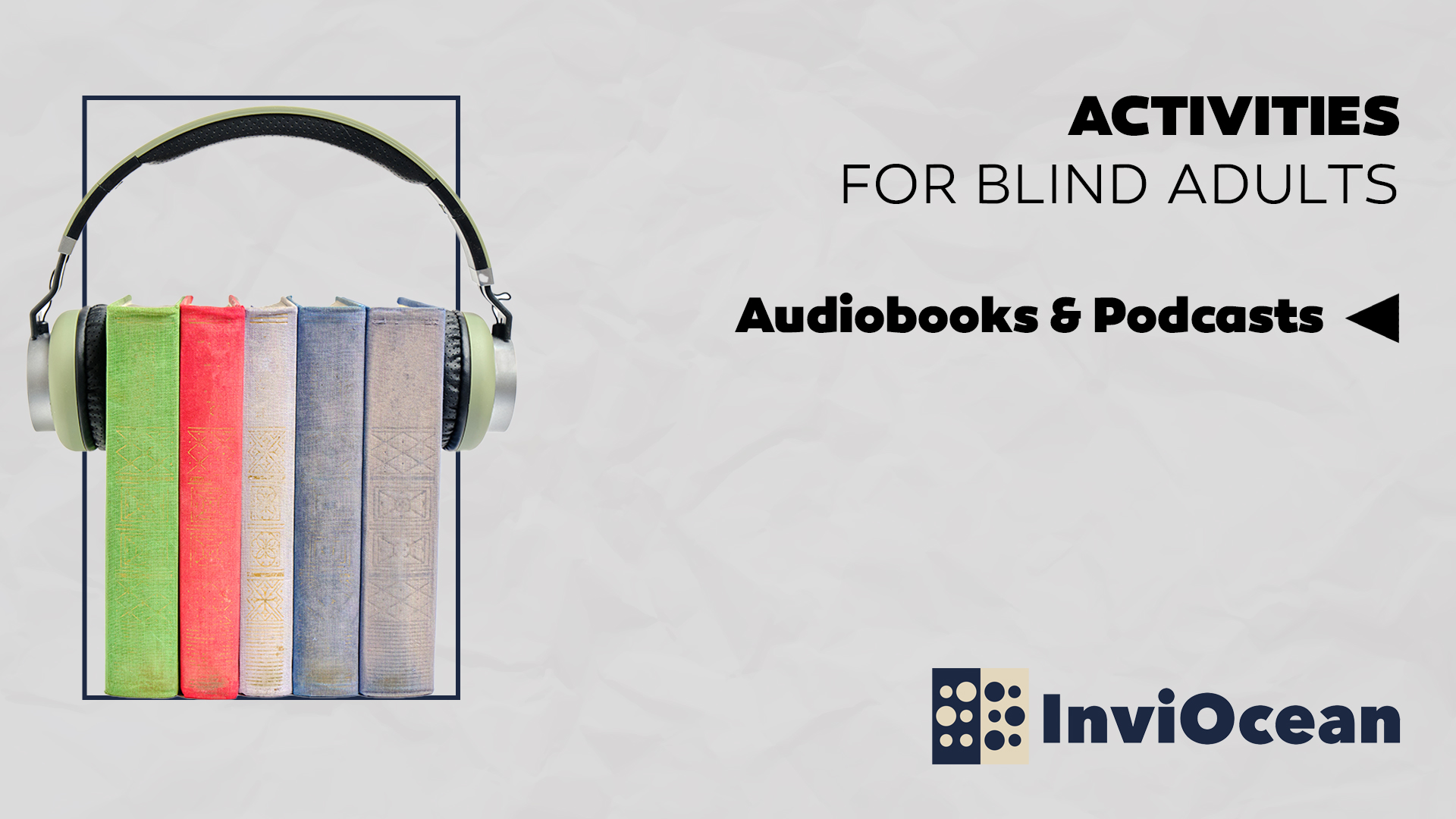Activities for the blind people: Guide
Living with visual impairments presents unique challenges, but it doesn’t limit the potential for rich, fulfilling experiences. Engaging activities tailored to the needs and preferences of blind individuals not only provide entertainment but also foster personal growth, social interaction, and a sense of empowerment. In this article, we explore a variety of activities designed to enhance the lives of those with visual impairments, promoting inclusivity and a vibrant lifestyle.
Activities for blind adults
For blind adults, the world of visual impairment activities is expansive and full of possibilities. Tailoring experiences to cater to sensory exploration, social engagement, and personal development ensures that individuals with visual impairments can lead active, fulfilling lives. In this article, we delve into a range of activities designed to empower blind adults, fostering a sense of independence, community, and joy.

Sports
- Adapted Sports and Recreation: Participating in adapted sports and recreational activities allows visually impaired adults to embrace the excitement of competition and camaraderie. Sports like goalball, blind cricket, and beep baseball feature specific adaptations that ensure inclusivity, making them thrilling and accessible choices.
- Mindful Practices: Yoga and Meditation: Yoga and meditation serve as powerful tools for promoting physical well-being, stress reduction, and mindfulness. Specially crafted yoga classes for visually impaired adults focus on verbal guidance, tactile feedback, and modified poses. These classes empower participants to enhance flexibility, balance, and overall wellness through a tailored approach.
- Expressive Movement: Dance and Physical Expression: Dance and movement provide a distinctive avenue for self-expression and physical involvement. Visually impaired individuals can partake in dance classes designed specifically for them, such as contemporary dance or salsa. In these classes, instructors offer descriptive cues, and partners provide guidance and support, ensuring an inclusive and fulfilling experience.

Adapting Games for Accessibility
Games, including cards and chess, can be modified to become hobbies for blind people. Here are different ways to adapt game equipment:
- Braille Versions: Games like chess, playing cards, Monopoly, Ludo, and Bingo are available in Braille versions. These adaptations ensure inclusivity by providing accessible options for individuals with visual impairments.
- Tactile Versions: Some games, such as dominoes or dice, feature raised numbers that can be easily discerned by touch. Tactile adaptations enhance the gaming experience for those with visual limitations.
- Large Print Versions: Many games are offered in large print formats, catering to individuals with low vision. Large print options include cards, Bingo, crosswords, and Scrabble, making these games more accessible and enjoyable.

Creative activities
- Painting and Drawing: Through innovative approaches like tactile paintings, raised outlines, and specialized tools such as swell paper and 3D pens, visually impaired individuals can craft stunning artwork. These adaptive techniques not only engage their sense of touch but also allow for the exploration of imagination, ensuring that artistic expression remains boundless.
- Pottery and Sculpting: The tactile and sensory experiences of working with clay become a gateway to creativity for visually impaired individuals. Whether molding clay into beautiful pottery or sculpting intricate figures, these endeavors rely on the sense of touch. Instructors skilled in adapting techniques ensure that individuals can explore the tactile aspects of pottery and sculpting, fostering a unique and fulfilling artistic journey.
- Woodworking: Embarking on woodworking endeavors can be an immensely rewarding experience for adults, presenting a captivating avenue to unleash creativity and hone problem-solving skills. Crafting intricate items such as furniture or toys not only sharpens motor skills but also enhances hand-eye coordination. Engaging in woodworking offers a unique sense of satisfaction as individuals witness their meticulous efforts culminate in tangible results, effectively transforming their visions into reality. Beyond the tactile joys of working with wood, woodworking fosters a sense of accomplishment, instills patience, and encourages a mindful approach to craftsmanship. Moreover, the varied techniques involved in woodworking, from carving to finishing, provide ample opportunities for continuous skill development and personal growth.

Cooking
Engaging in food preparation combines the pleasure of crafting delightful meals and desserts with the satisfaction of savoring the delicious results. Collaborating with an instructor, individuals with low vision can delve into their favorite recipes, refining precision techniques and enhancing accuracy in the culinary process. Adapting a kitchen for individuals who are blind or have low vision involves practical modifications to enhance accessibility. Marking equipment settings with bright colors or tactile tags, providing recipes in audio or large print formats, using adapted measuring tools, indicating the top or bottom of utensils with tactile cues, and incorporating pre-prepared ingredients are all effective strategies. These thoughtful adjustments empower individuals to navigate the kitchen independently and engage in the creative process of cooking with confidence.

Social activities
- Emotional Support and Connection through Support Groups: Participating in support groups and engaging in peer counseling offers a valuable source of emotional support, guidance, and a profound sense of belonging. For visually impaired adults, connecting with others who share similar challenges provides an avenue to share experiences and glean coping strategies, fostering a supportive network.
- Making a Positive Impact through Volunteer Work: Involvement in volunteer work and community service empowers visually impaired adults to contribute meaningfully to their communities. Through accessible volunteer programs, organizing events, or extending assistance to those in need, individuals can utilize their skills and talents to make a positive impact. This engagement not only fosters a sense of purpose but also brings a deep sense of fulfillment.
- Building Camaraderie through Clubs and Organizations: Joining clubs and organizations tailored to the interests of visually impaired individuals promotes social interaction and a strong sense of camaraderie. Whether it be a book club, music ensemble, or sports team, these groups create opportunities to meet like-minded individuals, forge friendships, and share common passions.

Art
Immersing oneself in the world of art through gallery visits, concerts, and museum outings enhances appreciation for diverse artistic expressions.
For low-vision adults, attending such cultural venues can involve listening to verbal descriptions and enjoying audio tours tailored to the exhibits. Additionally, actively participating in hands-on workshops, such as sculpting, painting, and photography sessions, offers a unique and immersive experience. These engagements not only provide valuable perspective on various art forms but also serve as a catalyst for inspiring creativity.
By combining the auditory richness of verbal descriptions and audio tours with the tactile and expressive nature of artistic workshops, individuals with low vision can cultivate a deep connection with art and its myriad forms of expression. This holistic approach not only enriches the appreciation of art but also fosters a sense of personal connection and fulfillment within the artistic realm.

Gardening
Engaging in gardening activities unfolds as a serene and therapeutic experience for adults with low vision. Beyond the immediate joys of tending to plants, gardening serves as a gateway to expanding knowledge about the environment, fostering sustainability, and enhancing sensory development.
Gardening offers a hands-on approach to understanding the delicate balance of nature and the interconnectedness of ecosystems. It provides opportunities for individuals to explore the intricacies of soil, plant life, and the nurturing processes that contribute to a thriving garden.
In addition to these cognitive and sensory benefits, the act of gardening extends an invitation for individuals to immerse themselves in the natural world. The outdoor setting allows for a refreshing escape into the open air, providing not only physical exercise but also a connection with the sights, sounds, and fragrances of the garden.
Whether cultivating vibrant flowers, growing nourishing vegetables, or simply enjoying the act of nurturing plant life, gardening becomes a holistic experience that goes beyond the visual limitations. It becomes a means of fostering a deep connection with nature, promoting overall well-being, and contributing to the creation of a sustainable and vibrant outdoor sanctuary.

Music and Dance
Unlocking the transformative joy of music and experiencing its healing power becomes a remarkable journey for visually impaired adults. Engaging in musical pursuits goes beyond mere entertainment; it becomes a gateway to building coordination skills, fostering social interaction, and tapping into the rhythmic essence of dance.
Exploring Musical Avenues:
- Drumming, with its tactile nature, allows individuals to feel the beats and rhythms, enhancing coordination and auditory awareness.
- Singing, whether solo or in a choir, becomes a means of self-expression and connection, immersing participants in the therapeutic realm of vocal melodies.
The Dance of Coordination:
- Ballroom dancing and salsa offer visually impaired individuals unique opportunities to refine coordination skills. Learning choreographed movements enhances spatial awareness and cultivates a harmonious connection between body and rhythm.
Rhythmic Social Interaction:
- Engaging in these musical and dance activities provides not only personal enjoyment but also a platform for social interaction. Shared experiences in group settings amplify the joy, fostering connections and friendships.
The Therapeutic Power of Music:
- Beyond the physical benefits, music serves as a therapeutic medium, offering emotional expression and stress relief. Participating in musical and dance activities becomes a holistic endeavor, addressing both physical and emotional well-being.

Audiobooks & Podcasts
For individuals with low vision, the world of audiobooks and podcasts unfolds as a gateway to boundless knowledge and personal growth. Beyond being a source of entertainment, these auditory experiences provide a unique opportunity to delve into various subjects, enhancing comprehension and communication skills. Audiobooks offer an immersive exploration of history, science, culture, and more. Through the spoken word, individuals can discover the secrets of the past, delve into scientific breakthroughs, and gain insights into diverse cultures, fostering continuous learning and intellectual enrichment.
Engaging with captivating fiction stories through audiobooks opens doors to imaginative realms and vivid narratives. Whether it’s a thrilling mystery, a heartwarming romance, or a sci-fi adventure, these stories provide a delightful escape, stimulating creativity and igniting the imagination.
Listening to podcasts with varying formats, including interviews, discussions, and storytelling, allows individuals to refine their communication skills. Exposure to diverse conversational styles enhances the ability to articulate thoughts and engage in meaningful discourse. Audiobooks and podcasts offer a flexible and accessible way for individuals with low vision to consume content. Whether at home, during commutes, or while engaging in other activities, these audio formats provide a convenient means of staying informed and entertained.

Technologies
Accessible Apps and Games:
- The digital landscape is witnessing a surge in accessible apps and games specifically designed for visually impaired individuals. From navigation apps equipped with voice guidance to engaging audio-based games and puzzle apps, these digital offerings serve as versatile tools for entertainment, education, and skill development.
- Educational apps cater to various subjects, fostering continuous learning in an accessible format. Additionally, productivity apps equipped with voice commands and screen readers enhance daily tasks, promoting independence and efficiency.
- Gaming experiences have evolved to include accessible features such as auditory cues, tactile feedback, and adaptable interfaces. From strategic challenges to recreational entertainment, visually impaired individuals can actively participate in the diverse world of digital gaming.
Virtual Reality Experiences:
- The advent of Virtual Reality (VR) technology introduces visually impaired adults to immersive virtual environments. VR experiences transcend physical limitations, enabling individuals to explore simulations, visit places, and engage in activities that might be challenging in the physical world.
- These VR simulations are not merely entertainment; they serve as powerful tools for experiential learning. Users can virtually travel to historical landmarks, participate in interactive educational scenarios, or even engage in vocational training simulations, broadening their horizons.
- The interactive nature of VR experiences fosters a sense of exploration and curiosity. Visually impaired individuals can delve into immersive environments that stimulate their senses, providing novel and enriching experiences that might not be readily accessible in their daily lives.
In conclusion, the array of activities designed for individuals with visual impairments is wide. From engaging in adapted sports and the therapeutic benefits of arts like painting and drawing to the diverse world of accessible technology, these activities break down barriers and create avenues for personal growth and fulfillment. Support groups, volunteer work, and social organizations further contribute to building a strong sense of community and shared experiences. As we explore these activities, it becomes evident that the richness of life knows no visual bounds. The potential for joy, learning, and connection remains boundless for individuals with visual impairments.
Blind and partially sighted individuals can actively participate in a variety of sports, regardless of age or ability. Whether it’s football, rock climbing, rugby, athletics, or archery, there are diverse opportunities for engagement. Discover the range of options available and how you can join in.
There are numerous career options tailored to individuals with visual impairments. Traditional roles include piano tuners, massage therapists, receptionists, and lawyers. While these have been historically encouraged, they continue to offer viable and fulfilling career paths for blind individuals today.
Goalball takes the spotlight as the premier sport designed exclusively for people who are blind or have low vision. Introduced to Australia in 1980, Goalball is played indoors, featuring teams of three players each, defending three goals in this uniquely inclusive sport.
